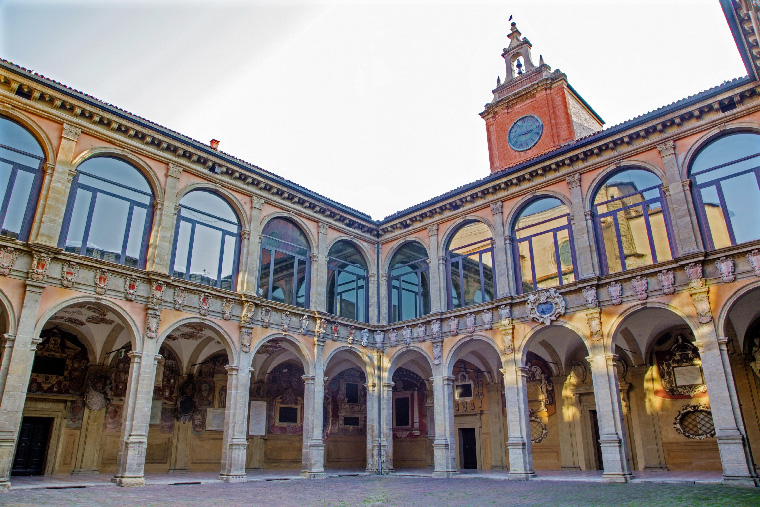Let’s say you are a curious traveler who finds him or herself dawdling under the ever-present portici of Bologna on a sunny Sunday afternoon. Let’s also say that you are passionate about Italian art and culture and that you want to know more about this beautiful city’s past and present lifestyle. If so, there is a place you should absolutely not miss: just a few steps away from the Neptune Fountain and the Piazza Maggiore main square, the Archiginnasio lurks in the shade of the arcades to attract all the “dawdlers” who pass by, as it has been doing for centuries.

Nowadays seat of a renowned civic library, this building has a history that goes far back in time to the final year of the Council of Trent in 1563. It was then that the local architect Antonio Morandi, called Terribilia, supervised the construction of this palace, erected at the papal legate’s will in order to give the University of Bologna the main seat it had until then lacked. Yet, as one learns about how rooted in time this place is, it is unavoidable to be intrigued not only by its history, but by the many intertwined stories that have literally left a mark in the silent rooms of the Archiginnasio as well.
Let’s say you have by now followed my advice and decided to take a peek under the porticoed facade of the Archiginnasio: as soon as you step into the passage that leads to its double lodged courtyard, the choice to spend some time inside and pay a visit should seem reasonable enough. As it would probably appear to you by simply turning your eyes to the first frescoed ceilings, the place is all but conventional: and you can say that again, as it turns out that this dreamlike location in central Bologna is home to the world’s largest heraldic wall complex. As a matter of fact, during the two and a half centuries in which the Archiginnasio was the seat of the oldest university in the world – and before its eventual transformation into a library occurred at the beginning of the 19th century – the whole palace was adorned with about six thousand family crests and coats of arms.
Sure enough, these are the signs left in the halls and corridors to commemorate the masters and students who came here from all around the globe to attend the prestigious “Studio Bolognese”, at the same time testifying to the place’s unique commingling of world history and personal stories. One such case is that of Diego de Leon Garavito, who made all his way from Lima, Perù around 1605 and is now remembered as the first “American” student ever in Bologna: his inscription, among the many others that surround the courtyard, waits you on the entrance walls and seems to let you in with its peculiarity. All you have to do is to follow.
And if you keep following my advice, and keep moving your curious eyes from one coat of arms to another, you would soon be escorted by them through the two grand staircases that lead to the floor above, still inscribed with names and places. In the meantime, by exploring the wonders of the Archiginnasio you would have realized how Bologna got to be known as “la dotta”, the learned one: judging from what the painted walls themselves say, the city has long been the student-friendly cultural center it is today.
But there still are other wonders waiting you in the rooms upstairs: among them, the so-called Anatomy Theater, built in 1637 and entirely made of spruce wood. Under the wonderful paneled ceiling representing the constellations, sculptures in their wooden stillness portray some celebrated doctors, to begin with Hippocrates and Galen, while the two skinned men known as “Spellati” overlook the white marble dissection table in the middle of the room. A fascinating hall indeed, and slightly macabre too, for that matter. Yet the marvel of all marvels is to know that this whole area of the Archiginnasio, heavily damaged by the air raids of the Second World War, has somehow survived time itself: soon after the conflict, the Anatomy Theater was fully restored to its former splendor by using the original statues.
By leaving the room and moving forward to the last wing of the palace, the wounds opened by the bombs are still visible in the silent corridors where no heraldic symbol remains. But as you reach the famous Stabat Mater Lecture Hall, in which this exploration comes to an end, the beauties of the Archiginnasio are once again impressed upon your memory. Ultimately, you can almost imagine that night in 1842 when Gaetano Donizetti first directed Rossini’s “Stabat Mater” precisely in this hall, surrounded by these myriad coats of arms.




























